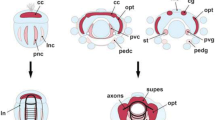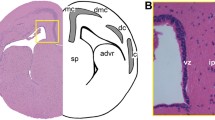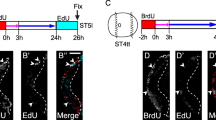Summary
Neurogenesis, cell migration and early histogenesis of the isthmic nuclear complex in chick embryos were investigated in autoradiographic and Golgi material. The aim of the experimental observations was to detect whether the apparent origin of different grisea of this complex at separate matrix territories (neuromeres) was accompanied by peculiar generation patterns, consistent with predictions of neuromeric theory. Differential birthday patterns were indeed obtained for a) n. semilunaris — born in the rh1a rhombomere, b) n. isthmi principalis pars parvocellularis, nn. lemnisci lateralis dorsalis and ventralis, and n. isthmi ventralis — born in the isthmic rhombomere, and c) n. isthmi principalis pars magnocellularis — born at the m1 mesomere. Only the nuclear group at (b) shows a clear-cut gradient of generation.
The morphological analysis aimed to describe isthmic neuroblast cell form before, during and immediately after migration into the mesencephalic optic lobe. Golgi data indicate that isthmic neuroblasts emerge as free cells from the matrix and aggregate into a dense superficial mantle layer. Between stages HH26 and 30, the whole mass of cells translocates tangentially in a rostrolateroventral direction, invading the m2 mesomere. The individual migrating neuroblasts have a leading axonal process which rapidly grows into the tectum in advance of the cell body, which follows at a slower pace. As the migration runs to an end the neuroblasts start to differentiate, sprouting dendritic processes.
A joint origin in the isthmic mantle primordium is proposed for the nuclear group at (b) (above), whereas n. isthmi principalis pars magnocellularis is formed separatedly from the rest, and shows no tangential migratory behaviour of its neuroblasts. The complex histogenetic and morphogenetic processes at the isthmo-mesencephalic boundary may be explained on the basis of these new data, but this requires a tridimensional viewpoint that is exposed in the Discussion.
Similar content being viewed by others
Abbreviations
- C :
-
cerebellar plate
- d :
-
dorsal isthmic matrix
- dl :
-
dorsolateral isthmic matrix
- flm :
-
fasciculus longitudinalis medialis
- I :
-
intermediate isthmic layer
- J-O :
-
isthmo-optic nucleus
- IP :
-
nucleus isthmi principalis
- IPm :
-
nucleus isthmi principalis, pars magnocellularis
- IPp :
-
nucleus isthmi principalis, pars parvocellularis
- Ist :
-
isthmic neuromere
- itt :
-
isthmotectal tract
- Iv :
-
nucleus isthmi ventralis
- L :
-
lemniscal complex
- LL :
-
nucleus lemnisci lateralis
- LLd :
-
nucleus lemnisci lateralis, pars dorsalis
- LLv :
-
nucleus lemnisci lateralis, pars ventralis
- M :
-
isthmic mantle layer
- m1, m2 :
-
mesencephalic neuromers (mesomeres)
- Mes :
-
mesencephalon
- mteg :
-
mesencephalic tegmentum
- nVIII :
-
statoaccoustic nerve
- rh1, rh4 :
-
rostral rhombencephalic neuromers (rhombomeres)
- Romb :
-
rhombencephalon
- SL :
-
nucleus semilunaris
- T :
-
trochlear nucleus
- tect :
-
tectal primordium
- teg :
-
isthmic tegmentum
- tor :
-
torus semicircularis primordium
- tt :
-
tectothalamic tract
References
Altman J, Bayer SA (1979) Development of the diencephalon in the rat. VI. Re-evaluation of the embryonic development of the thalamus on the basis of Thymidine-radiographic datings. J Comp Neurol 198:677–716
Altman J, Bayer SA (1980a) Development of the brain stem in the rat. I. Thymidine-radiographic study of the time of origin of neurons of the lower medulla. J Comp Neurol 194:1–35
Altman J, Bayer SA (1980b) Development of the brain stem in the rat. II. Thymidine-radiographic study of the time of origin of neurons of the upper medulla, excluding the vestibular and auditory nuclei. J Comp Neurol 194:37–56
Altman J, Bayer SA (1980c) Development of the brain stem in the rat. III. Thymidine-radiographic study of the time of origin of neurons of the vestibular and auditory nuclei of the upper medulla. J Comp Neurol 194:877–904
Altman J, Bayer SA (1980d) Development of the brain stem in the rat. IV. Thymidine-radiographic study of the time of origin of neurons in the pontine region. J Comp Neurol 194:905–929
Altman J, Bayer SA (1981) Development of the brain stem in the rat. V. Thymidine-radiographic study of the time of origin of neurons in the midbrain tegmentum. J Comp Neurol 198:677–716
Altman J, Bayer SA (1982) Development of the cranial nerve ganglia and related nuclei in the rat. Adv Anat Embryol Cell Biol 74:1–90
Bengmark S, Hugosson R, Kallen B (1953) Studien über Kernanlagen im Mesencephalon sowie im Rostralteil des Rhombencephalon von Mus musculus. Z Anat Entwickl Gesch 117:73–91
Bergquist H (1954) Ontogenesis of diencephalic nuclei in vertebrates. A comparative study. Kgl Fysograf Sallskap i Lund Handl 6:1–34
Bergquist H, Kallen B (1953) Studies on the topography of migration areas in the vertebrate brain. Acta Anat 17:353–369
Bergquist H, Kallen B (1954) Notes on the early histogenesis and morphogenesis of the Central Nervous System in vertebrates. J Comp Neurol 100:627–659
Clarke PGH (1982) The generation and migration of the chick's isthmic complex. J Comp Neurol 207:208–222
Coggeshall RE (1964) A study of diencephalic development in the albino rat. J Comp Neurol 122:241–269
Harkmark W (1954) Cell migrations from the rhombic lip to the inferior olive, the nucleus raphe and the pons. A morphological and experimental investigation on chick embryos. J Comp Neurol 100:115–211
Hart JR (1970) Some observations on the development of the avian optic tectum. Doctoral Thesis. Univ Michigan
Herrick CJ (1948) The brain of the tiger salamander. Univ Chicago Press, Chicago, pp 191–211
His W (1893) Vorschläge zur Einteilung des Gehirns. Arch Anat Physiol Anat Abt III/IV:172–179
Holley JA (1982) Early development of the circumferential axonal pathway in mouse and chick spinal cord. J Comp Neurol 205:371–382
Hugosson R (1957) Morphologic and experimental studies on the development and significance of the rhombencephalic longitudinal cell columns. Thesis, Lund Sweden
Kallen B (1965) Early morphogenesis and pattern formation in the central nervous system. In: Organogenesis. DeHaan RL, Ursprung H (eds) New York
Keyser A (1972) The development of the diencephalon of the chinese hamster. Acta Anat 83:1–181
LaVail JH, Cowan WM (1971) The development of chick optic tectum. II. Autoradiographic studies. Brain Res 28:421–441
Lavilla J (1942) Estabilización de las coloraciones cromoargénticas. Arch Hist Norm Patol 1:441
Martinez-de-la-Torre M (1980) Diferenciación neuroblástica en el nucleo istmico principal parvocelular del pollo. Tesis de Licenciatura, Univ Cadiz
Palmgren A (1921) Embryological and morphological studies on the midbrain and cerebellum of vertebrates. Acta Zool 2:1–94
Ramon y Cajal S (1929) Etudes sur la neurogenèse de quelques vertébrés. Madrid, p 16
Rendahl H (1924) Embryologische und morphologische Studien über das Zwischenhirn beim Huhn. Acta Zool 5:241–344
Richter E (1965) Die Entwicklung des Globus Pallidus und des Corpus Subthalamicum. Monograph Gesamtgeb Neurol Psychiatr 108:1–131
Rogers AW (1967) Techniques of autoradiography. Elsevier, New York, pp 324–325
Rüdeberg SI (1961) Morphogenetic studies on the cerebellar nuclei and their homologization in different vertebrates including man. Thesis, Lund Sweden (Hakon Ohlssons boktryckeri)
Spatz H (1925) Über die Entwicklungsgeschichte der basalen Ganglien des menschlichen Großhirns. Erg Bd Anat Anz 60:54–58
Stensaas LJ (1967) The development of hippocampal and dorsolateral pallial regions of the cerebral hemisphere in fetal rabbits. I. Fifteen millimeter stage, spongioblast morphology. J Comp Neurol 129:59–70
Vaage S (1969) The segmentation of the primitive neural tube in chick embryos (Gallus domesticus). Erg Anat Entwickl Gesch 41:1–88
Vaage S (1973) The histogenesis of the isthmic nuclei in chick embryos (Gallus domesticus). I. A morphological study. Z Anat Entwickl Gesch 142:283–314
Wentworth LE (1984) The development of the cervical spinal cord of the mouse embryo. II. A Golgi analysis of sensory, commissural, and association cell differentiation. J Comp Neurol 222:96–115
Author information
Authors and Affiliations
Rights and permissions
About this article
Cite this article
Puelles, L., Martinez-de-la-Torre, M. Autoradiographic and Golgi study on the early development of n. isthmi principalis and adjacent grisea in the chick embryo: a tridimensional viewpoint. Anat Embryol 176, 19–34 (1987). https://doi.org/10.1007/BF00309748
Accepted:
Issue Date:
DOI: https://doi.org/10.1007/BF00309748




